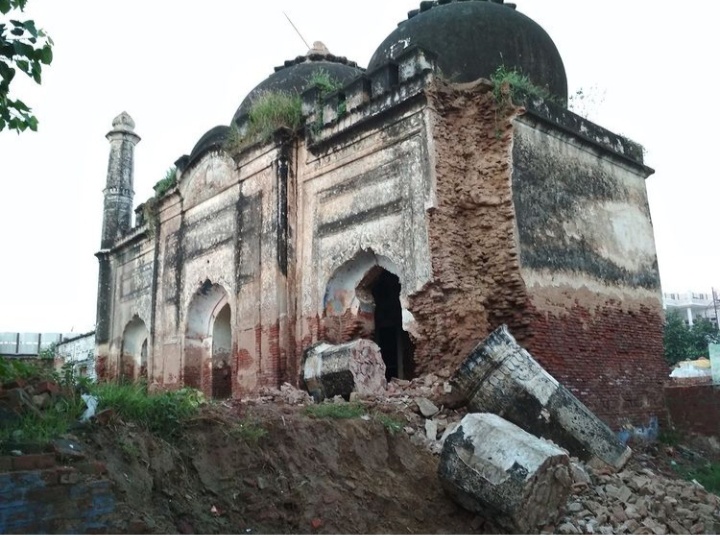Mohammad Mirza is a travel writer and a social media executive from Hyderabad. He is currently based in the Middle East. His Instagram page “Mosques of India” is stocked with images of abandoned mosques with striking architecture that has remained elusive to the imaginations of present-day craftsmen.
Shalini S, TwoCircles.net
Ten years ago, walking through the bustling street of Shaikpet in Hyderabad, thirty-year-old Mohammad Mirza was distraught to see the sight of a tumbledown Shaikpet mosque. Once, the Shaikpet mosque would echo with prayers, stirring the hearts of many. Seeing the plight of the mosque, Mirza started on a journey to research and write about the abandoned “Mosques of India.”
His aim is for the Archaeological Survey of India (ASI) and Muslim Waqf Boards to recognize these mosques as state-protected monuments.
Mirza is a travel writer and a social media executive from Hyderabad. He is currently based in the Middle East. His Instagram page “Mosques of India” is stocked with images of abandoned mosques with striking architecture that has remained elusive to the imaginations of present-day craftsmen.

“I started writing about the abandoned mosques of India in lockdown. I am a history junkie and I read vastly on architecture,” Mirza told TwoCircles.net.
“I didn’t want to post the images of the mosques alone. I wanted to create awareness about their poor and dilapidated condition. I also try to extensively research and write about the historical significance and the cultural heritages of these mosques,” he said.
His page features an assortment of solitary mosques, which include the Palaiya Jumma Palli, one of the oldest mosques in India located at Keelakari in Tamil Nadu, which has a semblance of Dravidian Islamic Architecture and was constructed around 628 – 630 AD, the Akbari mosque in the sleepy town of Kalanaur, Punjab. The Akbari mosque is speculated to be the coronation place of Akbar the Great. Each mosque featured on the page has a unique ‘unknown’ history but are in ruins at present.

“The Arabic calligraphy and inscriptions are still intact in some mosques, but most of the mosques are in a very bad condition. The minarets and domes are broken. The walls of the mosques have plants and trees growing out of their fissures, and sometimes they are just cloaked in algae,” says Mirza.
Mirza archives the heritage of these mosques by doing ‘short series’ items on these old and abandoned mosques. “The short series helps people to focus on a particular place filled with heritage,” he says.
In his first series, he wrote about eight different “Abandoned Mosques of Haryana” (as he calls it). It featured mosques from the villages of Gondar, Fatehabad, Kahni, Turkiawas, Meham, Dujana, Urlana Kalan and Jalmana.
“Sadly today these mosques are encroached and used as residences and cowsheds. Mosques used to be a house of prayer for Muslims. There are no Muslims in these small villages to worship in these mosques as they have migrated during the partition,” he says.
In one of his series, Mirza writes that Haryana is blessed with so many historical monuments, and “there is perhaps no other state in India where historic monuments are left to vagaries of nature like they are in Haryana.” He is talking about a forsaken mosque of Fatehabad, Haryana.
Mirza says that these mosques are the symbol of India’s pluralism and they must be preserved. “Not only mosques, I see many historical monuments in ruins too. Conserving the architectural heritage of a place depends upon the state’s recognition of its value,” he said.
Mirza says that “we must rebuild all these mosques so that our future generation can see all of this great history of their predecessors.”
“Hopefully, Muslims can visit and transfer these mosques hopefully,” says one of the followers on his page.
Mirza’s work is in line with Adopt a Heritage (2018) scheme, which was jointly established by the Ministry of Tourism, Ministry of Culture and Archaeological Survey of India. The project faced repercussion for its public-private partnership to sustain the monuments of cultural heritage and for selecting the sites based on tourist footfall. Activists had then sought to take into consideration the need to preserve and manage such cultural heritage before the adoption policy.
“These mosques are not just cultural heritage, they have religious significance too. The respective estates must give recognition to them and bring them under their protection,” says Mirza and adds, “I always wanted to be an armchair historian.”


